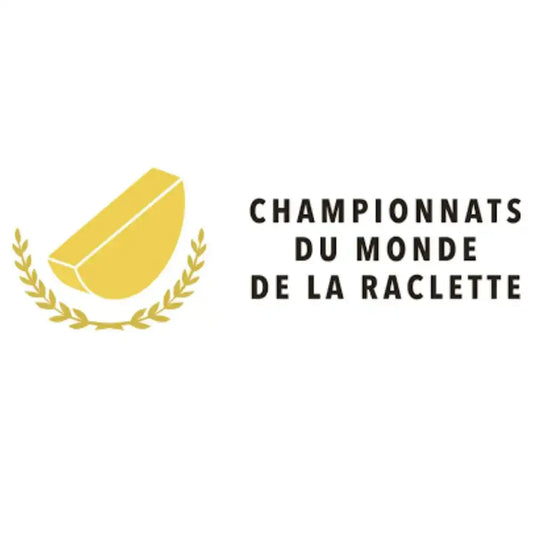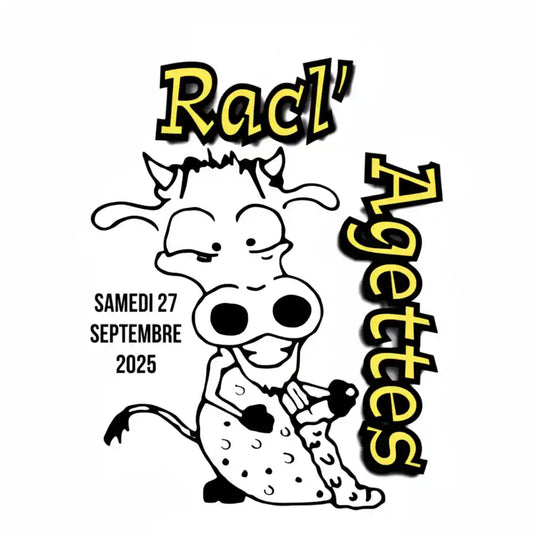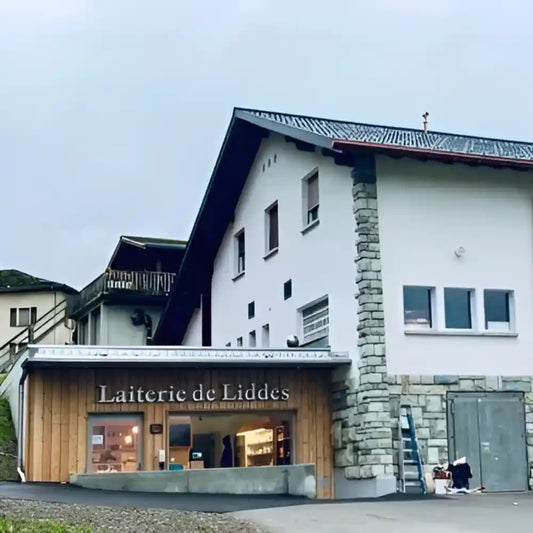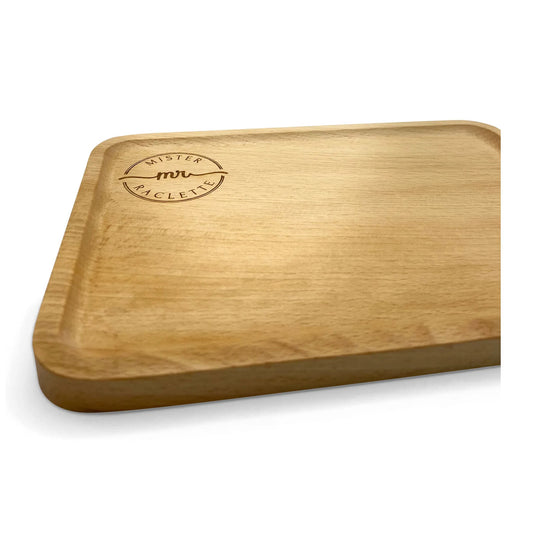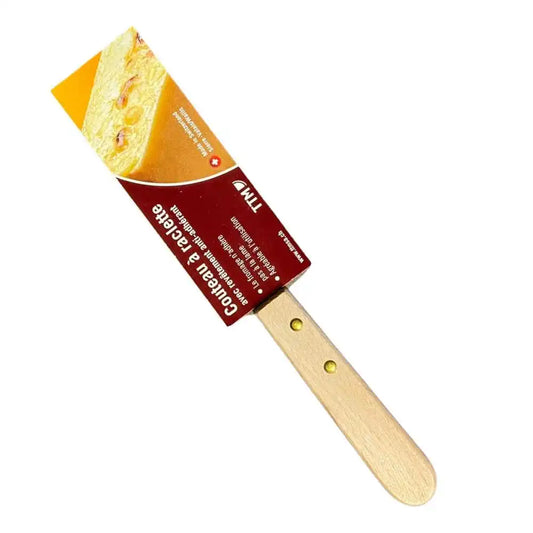Fabrication du fromage à raclette
Processus détaillé de fabrication du fromage à raclette du Valais
Le fromage à raclette, véritable emblème de la gastronomie suisse, est le fruit d'un savoir-faire artisanal transmis de génération en génération. Spécialement protégé par l’AOP "Raclette du Valais", ce fromage est produit exclusivement à partir de lait cru et selon des techniques rigoureuses respectueuses de la tradition. Cet article explore en profondeur chaque étape de sa fabrication, depuis la traite des vaches jusqu'à l'affinage, en s'appuyant uniquement sur des faits documentés. La fabrication du fromage à raclette du Valais illustre parfaitement l’harmonie entre les traditions séculaires et les exigences modernes en matière de qualité.
L'alimentation des vaches et la qualité du lait

Le lait cru, ingrédient essentiel à la fabrication du fromage à raclette du Valais. Il provient de vaches nourries à 75 % avec des fourrages produits dans l'aire géographique de l'AOP. L’usage d’ensilage est strictement interdit, garantissant une qualité optimale du lait. Chaque vache bénéficie d'une alimentation naturelle qui influe directement sur la richesse du fromage à raclette.
Les éleveurs jouent un rôle crucial dans la sélection et le stockage des fourrages pour garantir une alimentation équilibrée et conforme aux critères de l'AOP. Les variations saisonnières influencent également la composition du lait, ajoutant une diversité de saveurs au fromage à raclette. En été, lorsque les vaches paissent librement dans les alpages, leur alimentation enrichit le lait d'arômes floraux uniques.
Une anecdote historique raconte que, dans le Valais du Moyen Âge, les bergers montaient avec leurs troupeaux dans les alpages pendant les mois d’été. Ces bergers, éloignés des villages, emportaient toujours du fromage à raclette. Non seulement pour sa valeur nutritive mais aussi pour sa capacité à être fondu sur un feu improvisé. Cette tradition a perduré et s’est transformée en une véritable icône gastronomique.
Après la traite, le lait est refroidi à moins de 8 °C dans un délai de deux heures. Ce lait est livré une ou deux fois par jour à la fromagerie. Il doit être utilisé dans les 24 heures suivant sa collecte, en respectant les normes de fraîcheur exigées par l'AOP. La qualité du lait cru est contrôlée à chaque étape pour s’assurer qu’il répond aux standards élevés de la fabrication du fromage à raclette du Valais AOP.
La maturation et les cultures bactériennes

Le lait cru est versé dans une cuve en cuivre, un matériau qui favorise une excellente conductivité thermique. Tout en permettant une interaction optimale avec les bactéries lactiques. Les cultures bactériennes, comme la culture RA 401, sont ajoutées pour stimuler l’acidification et empêcher le développement de germes indésirables. Le lait est chauffé à 32 °C et laissé reposer pendant 30 à 60 minutes. Un temps de prématuration crucial pour définir le goût final du fromage à raclette à pâte dure.
Cette étape est également influencée par la qualité initiale du lait, qui doit contenir une flore microbienne naturelle équilibrée. Les bactéries introduites lors de la maturation jouent un rôle déterminant dans la création des arômes spécifiques du fromage à raclette. La culture bactérienne contribue également à la texture homogène à pâte dure du fromage à raclette, essentielle pour sa capacité à fondre uniformément.
L’emprésurage et la coagulation

Une fois la maturation terminée, la présure, issue de la caillette de veau, est incorporée au lait à une température de 30 à 33 °C. Cette étape délicate, appelée emprésurage, entraîne la coagulation du lait, transformant le liquide en une masse solide de caillé en environ 30 minutes. La qualité de ce caillé est déterminante pour la suite du processus.
Une autre histoire locale rapporte que les premiers fromagers valaisans utilisaient des présures improvisées, issues de plantes sauvages locales. Cette méthode ancienne, bien que moins précise, montre comment la fabrication de la raclette s’est adaptée avec le temps. Pour intégrer des innovations tout en respectant les traditions.
Les maîtres fromagers effectuent un contrôle visuel et tactile du caillé pour s’assurer qu’il a atteint la bonne consistance. Toute variation dans la coagulation peut affecter la texture et le goût du produit final. L’emprésurage est une phase où l’expérience et l’intuition du fromager sont particulièrement sollicitées, car chaque lot de lait peut réagir légèrement différemment.
Le décaillage, le brassage et les caractéristiques du fromage

Le caillé est obtenu avec le découpage du caillé en grains réguliers, de la taille d’un grain de riz ou de maïs (à l’aide d’un tranche-caillé). Ce découpage précis, appelé décaillage, permet d’évacuer le petit-lait tout en conservant les propriétés du futur fromage à raclette. Le mélange est chauffé progressivement entre 36 et 45 °C pour raffermir les grains, puis brassé pendant environ 30 minutes pour garantir une texture uniforme.
Le décaillage et le brassage influencent directement la capacité de fonte du fromage à raclette, un critère essentiel pour la raclette. Les grains de caillé doivent conserver un équilibre parfait entre fermeté et élasticité. La maîtrise de ces étapes garantit une caractéristique du fromage avec une texture finale fondante et onctueuse, idéale pour une raclette conviviale.
Le moulage et le pressage

Dans la suite de la production, les grains de caillé sont ensuite rassemblés dans des moules. Ces simples meules de fromage subissent un pressage progressif pendant au moins quatre heures, avec plusieurs retournements du moule avec soin pour assurer un égouttage homogène. Durant cette étape, le pH est contrôlé avec précision, devant se situer entre 4,8 et 5,2 pour garantir une texture et un goût parfaits.
Le choix des moules et la pression exercée lors de cette étape influencent la structure interne du fromage à raclette à pâte dure. Un pressage insuffisant peut entraîner des poches d’air, tandis qu’un pressage excessif risque de rendre le fromage trop dense. Les meules ainsi formées sont prêtes à entrer dans la phase de salage, où elles acquerront leur croûte protectrice et leur saveur caractéristique.
Le salage : immersion dans la saumure

Le salage, étape essentielle dans le processus de fabrication. Il peut être effectué à la main ou par immersion des meules dans un bain de saumure concentrée (18 à 22 °Bé) à une température de 8 à 15 °C. Cette immersion dure environ 24 heures et remplit plusieurs fonctions : renforcer la croûte, affiner la saveur et agir comme un conservateur naturel en limitant le développement de bactéries indésirables.
Le sel joue également un rôle dans l’équilibre hydrique du fromage à raclette, influençant sa capacité à vieillir correctement. La concentration et la durée du bain de sel sont ajustées en fonction de la taille des meules. Un salage insuffisant pourrait compromettre le processus d’affinage, tandis qu’un excès de sel pourrait dominer les arômes naturels du fromage à raclette.
L'affinage : patience et savoir-faire

Après le salage, les meules sont placées dans des caves d’affinage, où elles resteront pour une période minimale de trois mois. Les conditions sont strictement régulées : une température entre 7 et 14 °C et une humidité de 88 à 96 %. Les fromages sont retournés quotidiennement pendant les dix premiers jours, puis deux à trois fois par semaine par la suite.
Ils sont également frottés régulièrement avec une solution salée enrichie en Brevibacterium linens. Une bactérie clé pour développer la morge, cette croûte orangée caractéristique qui contribue à la saveur unique du fromage à raclette.
L’affinage est une phase où l’expérience du fromager est primordiale. Les variations dans la température et l’humidité peuvent altérer les caractéristiques finales du fromage à raclette. Les arômes, la texture et la couleur évoluent lentement au fil des semaines. Les fromages affinés révèlent des notes complexes qui enchantent les amateurs de raclette du Valais AOP. Plus le fromage est affiné, moins il aura de lactose (phase de délactosage)
Un élément crucial de cette étape est l’apposition d’un sceau de qualité sur chaque meule. Ce sceau, propre à chaque fromagerie, permet d’identifier l'origine de production et la date exacte de fabrication. Ce marquage garantit la traçabilité du fromage et offre une transparence totale au consommateur. Dans certaines fromageries, ce sceau devient également un signe de fierté locale, une marque de fabrique, soulignant le savoir-faire unique de l’établissement.
Le cycle des températures et la maîtrise des étapes de fabrication du fromage
Chaque étape de la fabrication du fromage à raclette est associée à des températures précises, qui jouent un rôle clé dans le résultat final. La coagulation, le décaillage, le chauffage et même l’affinage obéissent à une logique stricte, garantissant la texture, la saveur et la qualité du produit fini. Ce contrôle minutieux des températures est un savoir-faire transmis de génération en génération.
Les outils modernes permettent aux maîtres fromagers de surveiller et d’ajuster ces paramètres avec une grande précision, tout en respectant les traditions artisanales. Cette combinaison d’innovation et de respect des pratiques traditionnelles est au cœur du succès de la raclette du Valais AOP.
Conclusion
La fabrication et les caractéristiques du fromage à raclette est un art où chaque détail compte. Depuis la qualité du lait cru jusqu’à l’affinage en cave. Ce processus méticuleux, basé sur des techniques ancestrales et des normes rigoureuses, donne naissance à un produit d’exception. Qui fait la fierté du Valais et régale les amateurs de fromage à raclette à travers le monde. Chaque bouchée de raclette est une immersion dans le patrimoine culturel et gastronomique suisse, rappelant le lien profond entre l’homme, la nature et le savoir-faire artisanal.
Le respect de ces traditions garantit que le fromage à raclette reste un trésor culinaire intemporel, apprécié bien au-delà des frontières helvétiques. Ce patrimoine vivant continue d’évoluer, tout en restant fidèle à ses origines, pour le plus grand plaisir des amateurs de raclette. Bonne dégustation.


